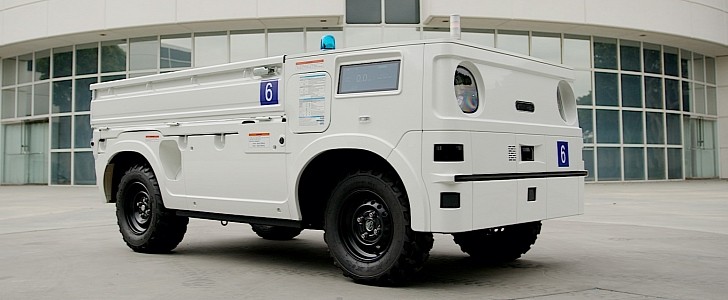The race to create autonomous vehicles is bound to bring to life some incredible contraptions over the next few years. Take the Honda Autonomous Work Vehicle (AWV), unveiled by the Japanese carmaker back in 2018.
Because of the nature of the work, the construction industry is, right behind that of transportation of humans or cargo, a real magnet for autonomous vehicles (AVs). And this is exactly what the AWV is meant for – a machine “capable of performing a wide range of services for industries that need a rugged off-road autonomous solution.”
To prove that point, Honda and engineering company Black & Veatch announced this week the completion of the first-ever test of a multitude of AWV machines “working collaboratively to support construction use cases.”
For the test, an undisclosed solar energy construction site was chosen, and the vehicles were asked to help with laying out support structures for solar panels. The idea was to test “the ability of the Honda AWV to stop at precise points along a pre-set route.”
Using sensors, GPS, radar, Lidar, and cameras, the AWVs had to navigate their way through start and stop points on the 1,000-acre site, delivering materials and supplies. They were capable of carrying close to 900 pounds (408 kg) of cargo each, and at one point even towed a trailer weighing twice as much.
“With our test partner, Black & Veatch, Honda was able to demonstrate the performance of our rugged all-electric Autonomous Work Vehicle prototype in a large-scale construction environment,” said in a statement Kenton Williams, U.S. project lead for the Honda AWV.
“We believe the Honda AWV has the potential to bring greater efficiencies, higher levels of safety and better environmental performance to the construction industry, and to other industries seeking an autonomous off-road solution.”
For Honda, this entire exercise was nothing more than a proof of concept, as no plans for the AWVs to enter production have been announced. Seeing these machines go about their business with no driver on board does however provide us with a glimpse of things to come, and a society significantly different than the one we live in today.
To prove that point, Honda and engineering company Black & Veatch announced this week the completion of the first-ever test of a multitude of AWV machines “working collaboratively to support construction use cases.”
For the test, an undisclosed solar energy construction site was chosen, and the vehicles were asked to help with laying out support structures for solar panels. The idea was to test “the ability of the Honda AWV to stop at precise points along a pre-set route.”
Using sensors, GPS, radar, Lidar, and cameras, the AWVs had to navigate their way through start and stop points on the 1,000-acre site, delivering materials and supplies. They were capable of carrying close to 900 pounds (408 kg) of cargo each, and at one point even towed a trailer weighing twice as much.
“With our test partner, Black & Veatch, Honda was able to demonstrate the performance of our rugged all-electric Autonomous Work Vehicle prototype in a large-scale construction environment,” said in a statement Kenton Williams, U.S. project lead for the Honda AWV.
“We believe the Honda AWV has the potential to bring greater efficiencies, higher levels of safety and better environmental performance to the construction industry, and to other industries seeking an autonomous off-road solution.”
For Honda, this entire exercise was nothing more than a proof of concept, as no plans for the AWVs to enter production have been announced. Seeing these machines go about their business with no driver on board does however provide us with a glimpse of things to come, and a society significantly different than the one we live in today.











